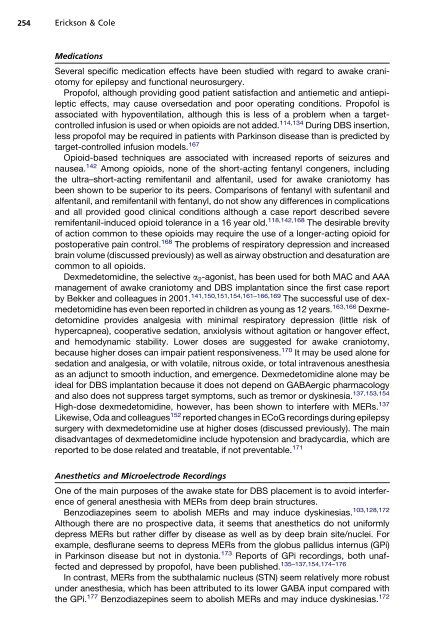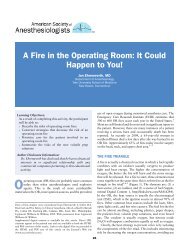Anesthetic Considerations for Awake Craniotomy for Epilepsy ... - Vtr
Anesthetic Considerations for Awake Craniotomy for Epilepsy ... - Vtr
Anesthetic Considerations for Awake Craniotomy for Epilepsy ... - Vtr
You also want an ePaper? Increase the reach of your titles
YUMPU automatically turns print PDFs into web optimized ePapers that Google loves.
254<br />
Erickson & Cole<br />
Medications<br />
Several specific medication effects have been studied with regard to awake craniotomy<br />
<strong>for</strong> epilepsy and functional neurosurgery.<br />
Propofol, although providing good patient satisfaction and antiemetic and antiepileptic<br />
effects, may cause oversedation and poor operating conditions. Propofol is<br />
associated with hypoventilation, although this is less of a problem when a targetcontrolled<br />
infusion is used or when opioids are not added. 114,134 During DBS insertion,<br />
less propofol may be required in patients with Parkinson disease than is predicted by<br />
target-controlled infusion models. 167<br />
Opioid-based techniques are associated with increased reports of seizures and<br />
nausea. 142 Among opioids, none of the short-acting fentanyl congeners, including<br />
the ultra–short-acting remifentanil and alfentanil, used <strong>for</strong> awake craniotomy has<br />
been shown to be superior to its peers. Comparisons of fentanyl with sufentanil and<br />
alfentanil, and remifentanil with fentanyl, do not show any differences in complications<br />
and all provided good clinical conditions although a case report described severe<br />
remifentanil-induced opioid tolerance in a 16 year old. 118,142,168 The desirable brevity<br />
of action common to these opioids may require the use of a longer-acting opioid <strong>for</strong><br />
postoperative pain control. 168 The problems of respiratory depression and increased<br />
brain volume (discussed previously) as well as airway obstruction and desaturation are<br />
common to all opioids.<br />
Dexmedetomidine, the selective a2-agonist, has been used <strong>for</strong> both MAC and AAA<br />
management of awake craniotomy and DBS implantation since the first case report<br />
by Bekker and colleagues in 2001. 141,150,151,154,161–166,169 The successful use of dexmedetomidine<br />
has even been reported in children as young as 12 years. 163,166 Dexmedetomidine<br />
provides analgesia with minimal respiratory depression (little risk of<br />
hypercapnea), cooperative sedation, anxiolysis without agitation or hangover effect,<br />
and hemodynamic stability. Lower doses are suggested <strong>for</strong> awake craniotomy,<br />
because higher doses can impair patient responsiveness. 170 It may be used alone <strong>for</strong><br />
sedation and analgesia, or with volatile, nitrous oxide, or total intravenous anesthesia<br />
as an adjunct to smooth induction, and emergence. Dexmedetomidine alone may be<br />
ideal <strong>for</strong> DBS implantation because it does not depend on GABAergic pharmacology<br />
and also does not suppress target symptoms, such as tremor or dyskinesia. 137,153,154<br />
High-dose dexmedetomidine, however, has been shown to interfere with MERs. 137<br />
Likewise, Oda and colleagues 152 reported changes in ECoG recordings during epilepsy<br />
surgery with dexmedetomidine use at higher doses (discussed previously). The main<br />
disadvantages of dexmedetomidine include hypotension and bradycardia, which are<br />
reported to be dose related and treatable, if not preventable. 171<br />
<strong>Anesthetic</strong>s and Microelectrode Recordings<br />
One of the main purposes of the awake state <strong>for</strong> DBS placement is to avoid interference<br />
of general anesthesia with MERs from deep brain structures.<br />
Benzodiazepines seem to abolish MERs and may induce dyskinesias. 103,128,172<br />
Although there are no prospective data, it seems that anesthetics do not uni<strong>for</strong>mly<br />
depress MERs but rather differ by disease as well as by deep brain site/nuclei. For<br />
example, desflurane seems to depress MERs from the globus pallidus internus (GPi)<br />
in Parkinson disease but not in dystonia. 173 Reports of GPi recordings, both unaffected<br />
and depressed by propofol, have been published. 135–137,154,174–176<br />
In contrast, MERs from the subthalamic nucleus (STN) seem relatively more robust<br />
under anesthesia, which has been attributed to its lower GABA input compared with<br />
the GPi. 177 Benzodiazepines seem to abolish MERs and may induce dyskinesias. 172




